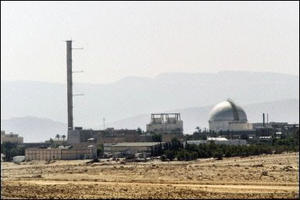Iran's bombIsrael, with U.S. help, tested Stuxnet at Dimona before attacking Iran
The New York Times quoted intelligence and military experts to say that U.S. and Israeli intelligence services collaborated to develop a destructive computer worm to sabotage Iran’s efforts to make a nuclear bomb; the Stuxnet computer worm shut down a fifth of Iran’s nuclear centrifuges in November and helped delay its ability to make its first nuclear weapons; before using Stuxnet to attack Iran’s nuclear program, Israel has tested the effectiveness of the malware at the heavily guarded Dimona complex in the Negev desert which houses Israel’s undeclared — and the Middle East’s sole — nuclear weapons program

Israel's Dimona nuclear reactor // Source: tundratabloids.com
Three months ago, based on our sources, we wrote that the Stuxnet virus was designed by cyber experts inside Israel’s Military Intelligence Unit 8200 with the aim of derailing Iran’s nuclear weapons program (Ben Frankel, “Skullduggery on a massive scale,” 11 October 2010 HSNW).
Yesterday, Sunday, the New York Times reached similar conclusions, reporting that U.S. and Israeli intelligence services collaborated to develop a destructive computer worm to sabotage Iran’s efforts to make a nuclear bomb. The newspaper quoted intelligence and military experts as saying Israel has tested the effectiveness of the Stuxnet computer worm, which apparently shut down a fifth of Iran’s nuclear centrifuges in November and helped delay its ability to make its first nuclear weapons.
The testing took place at the heavily guarded Dimona complex in the Negev desert housing Israel’s undeclared — and the Middle East’s sole — nuclear weapons program. Experts and officials told the Times the effort to create Stuxnet was a U.S.-Israeli project with the help, knowingly or not, of Britain and Germany.
“To check out the worm, you have to know the machines,” a U.S. expert told the newspaper. “The reason the worm has been effective is that the Israelis tried it out.”
There has been widespread speculation Israel was behind the Stuxnet worm that has attacked computers in Iran, and Tehran has blamed the Jewish state and the United States for the killing of two nuclear scientists in November and January.
The Times report came as Iran earlier said its controversial uranium enrichment program was progressing “very strongly,” just days ahead of a high-profile meeting between Tehran and six world powers over the Islamic republic’s nuclear program.
Both the United States and Israel have recently announced they believe the program has been set back by several years. U.S. secretary of state Hillary Clinton pointed to a series of sanctions imposed since June 2009 by the UN Security Council and individual countries.
Moshe Yaalon, Israel’s strategic affairs minister and former military chief, said last month that a series of “technological challenges and difficulties” meant Tehran was still about three years away from being able to build nuclear weapons.
Meir Dagan, who retired in December after eight years as head of the Mossad, said two weeks ago that Iran will not reach a nuclear weapons capacity until 2015, if then. Dagan, who is regarded as the architect of Israel’s sabotage and assassination campaign against Iran’s nuclear program, is known as an opponent of a direct military attack on Iran, arguing that a covert campaign, together with economic and political sanctions, would be sufficient for the task of preventing Iran from getting the bomb,.
Israel has backed U.S.-led efforts to prevent Iran from developing a nuclear weapons capability through sanctions, but has also refused to rule out military force.
Reuters reports that last Tuesday, Israeli prime minister Benjamin Netanyahu said international sanctions against Iran would only be effective if they were backed by a “credible” military threat.
The Stuxnet worm apparently included two major parts, one intended to make Iran’s nuclear centrifuges spin out of control.
Another secretly recorded normal operations at the nuclear plant, then played those recordings back to the site’s operators so all would appear usual during the sabotage operation, according to the Times.
Stuxnet targets computer control systems made by German industrial giant Siemens and commonly used to manage water supplies, oil rigs, power plants, and other critical infrastructure.
Most Stuxnet infections have been discovered in Iran, giving rise to speculation it was intended to sabotage nuclear facilities there.
The report came after Clinton, who was on a five-day trip to the United Arab Emirates, Oman, and Qatar last week, urged Arab states to stay focused on sanctions against Iran.
The UN Security Council last June imposed a fourth round of sanctions against Iran in a bid to halt its uranium enrichment program.
Iran says its aims are peaceful, denying charges by Israel and the West that its uranium enrichment work masks a drive for nuclear weapons.
The Islamic republic is set to hold a new round of nuclear talks with Britain, China, France, Germany, Russia, and the United States in Istanbul on 21 and 22 January.
